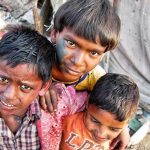A big problem with educating children in India is seasonal migration — if kids of seasonal migrants cannot attend the same school the entire year, how will their education level progress?
Globally, 763 million people are living outside of their native place which imposes a huge effect on the education of their children (GMR, 2019).In India, despite making laudable efforts to promote opportunities for local employment, inter-state migration rates have doubled between 2001 and 2011 (World Economic Forum, 2017) hence affecting the education of millions of children.
How does seasonal migration take place?
- In India, seasonal migration comprises a chunk of the population moving from rural to urban and rural to rural areas for a duration of minimum four months annually
- Seasonal migration is very high due to lack of employment opportunities at the native place which forces families or individuals to relocate
- Annually, 9 million people migrated between states from 2011 to 2016 (Ministry of Finance, 2017)
- Rampant seasonal migration primarily aligns with the agriculture season of the destination location; for example, during the month of October and November, there is a high rate of migration from states like Bihar, Madhya Pradesh, Rajasthan and Uttar Pradesh to Punjab, Haryana, Gujarat and Delhi. These families or individuals return home by June and July
- Majority of this type of migration has been of those people who are either semi-skilled or unskilled
- Generally, the family migrates as a full unit as parents do not want to leave the children behind in villages due to their safety and security
Effects on children’s education
Due to the nature of migration, the wellbeing of every migrant child gets highly compromised.
As per GMR, 80 per cent of children of seasonal workers never accessed education in India.
One of the key barriers is that there is no effective system at the community/school level to maintain data of seasonal migrant children.
Further, the teacher or school in the native location never consider these children as out-of-school children since they join back the school after a few months.
Meanwhile, at the destination, these children cannot access education due to their status as migrant, different enrollment procedure/norms for migratory children in schools, the location of schools, and differences in curriculum and linguistic barriers.
Due to the lack of an effective system both at the source and destination locations, the continuity in education for seasonal migrant children gets affected. Thus, these children do not gain the required skills and abilities at the right time.
7 problems children face due to seasonal migration:
- Continue to act as caregivers for younger siblings and family support
- Highly vulnerable to sexual exploitation
- No development of personality and intellectuality — remain trapped in the poverty cycle
- Insecure emotional and social abilities hence adjustment issues
- Poor connections with peers/ institutions, cannot contribute to society
- Declining interest of parents towards education for their education
- Unable to understand their rights and entitlements
Limited state provisions for children of seasonal migrants
- The Right to Education Act (2019) mandated provisions like maintaining/tracking a database of children by appropriate governments and local authorities to address this issue
- States like Gujarat, Maharashtra, Odisha, Andhra Pradesh, Tamil Nadu, and Karnataka have also taken initiatives to develop a mechanism to track migrant children for interstate coordination to ensure continuity of education
- Analysis of the annual work plans of the education departments of the above-mentioned states also shows that they have a specific plan for the coverage of migrant children. However, the resources of these plans require more serious and systemic attention
- As per reports, Uttar Pradesh and Bihar are the main source states for seasonal migration, closely followed by Madhya Pradesh, Punjab, Rajasthan, Uttarakhand, Jammu and Kashmir and West Bengal; these states require attention to issues of education for children affected by seasonal migration
- Key destination states like Delhi, Maharashtra, Tamil Nadu, Gujarat, Andhra Pradesh and Kerala need to have an aggressive mechanism for documentation, smooth enrollment of children, addressing curriculum and instructional issues etc
- To ensure educational provision for all migratory children, state governments should have a statistical account of their number and understanding of their location
Goal 4 of the UN Sustainable Development Goals comprising universal education cannot be achieved unless it becomes mandatory for each state government to provide education to migratory children by collaborating with different stakeholders, setting up interdepartmental convergence, easy school migration, and encouraging & motivating parents, establishing work-site education centers, seasonal hostels.
Article by Seema Rajput, Technical Specialist, and Dr Geeta Verma, Team Leader, CARE India, appeared in indiatoday.in on 11th December, 2018





